Overview
The Miraculous Statue of Marija Bistrica
The votive statue of the Mother of God of Marija Bistrica dates from the end of the 15th century and belongs to the series of black Madonnas, although it was discovered during restoration that its dark colour is not original.
The late Gothic wooden statue of the Bistrica Mother of God is the work of an anonymmous master. The expressive strength of this statue is less in the artistic achievement than in its very religious and national significance. The statue was firstly placed in the ancient shrine at Vinski Vrh in 1499, and then it was buried in Marija Bistrica in 1545 and rediscovered in 1588. It was forgotten again and walled in, then refound for the second time in 1684.

The removal of the statue, its hiding, and two findings awoke the belief in its miraculous power. The Mother of God of Bistrica has been the consolatrix of Christians during Turkish danger, a helper both in the First and the Second World Wars, as well as in the Homeland War.
Health for the sick, the refuge of sinners, the consolatrix of the sad, the helper of Christians, Mother of God of Bistrica, pray God for us!
The Declaration of the National shrine in 1971
At the autumn plenary session of the Bishops’ Conference of Yugoslavia, on December 3, 1971, Croatian bishops, promulgated the parish site of Marija Bistrica, recognized as a shrine by all Croatian people – the Croatian National Shrine of the Mother of God of Bistrica, the Queen of the Croats.
“The soul of Croatia,
the Mother of Jesus,
the sun during our sufferings,
do not stop shining!”
(Jeronim Korner, on the wall of the shrine)
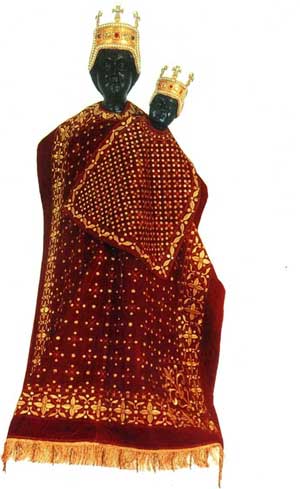

Ancient Shrine at Vinski Vrh (1499-1545)
The shrine of the Mother of God of Bistrica has a long, centuries-old history. The miraculous wooden black statue of the Holy Virgin originates from the 15th century, and it is the work of an unknown local master devoted to believers who suffered heavy misfortune.
Popular traditions says that the black wooden statue of the Mother of God (Vinnska) was first venerated in a wooden chapel, the earliest shrine of Bistrica, at Vinski Vrh from 1499 to 1545. Vinski Vrh is situated above the valley of the river Krapina and Zlatarsko Polje at an altitude of 282m, between Marija Bistrica and Konjščina, about three kilometres away from today’s shrine in Marija Bistrica.
Due to the permanent Turkish danger, especially after the Turks defeated the army of Nikola Zrinski at Konjščina on May 4, 1545, the parish priest Pavao (plebenus Paulus de Bisthriza) transferred the miraculous statue of Our Lady to Bistrica and buried it secretly under the choir of the parish church. He took the secret about the statue with him to his tomb.
The First Finding of the Miraculous Statue in 1588
Our Lady’s followers were constantly searching for the miraculous statue. The uncertainty was re- solved by a strange light coming from the choir of the parish church in Bistrica after the evening service. The folowing day the undamaged statue of Our Lady was unearthed. It was in 1588 during the parish priest Luka’s tenure, and, according to some documents, the parish priest Antun Plavasic’s (1574-1590). This was the first finding of the statue of the Mother of God of Bistrica and its setting up on the altar for worship.
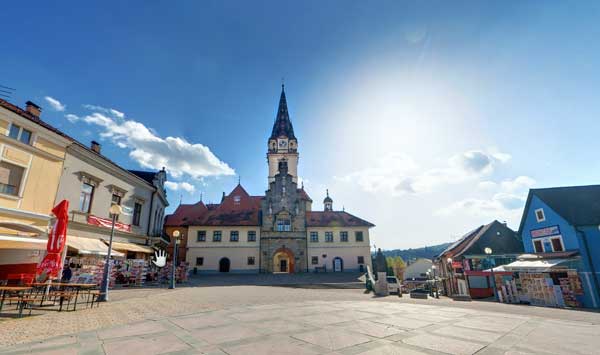

The Hiding Again of the Miraculous Statue in 1650
Due to constant Turkish danger, when the Turks invaded the country as far as Zlatarsko Polje in 1650, the statue was hidden for the second time. It was placed in the area behind the main altar in the parish church and walled in, but an opening was left for Our Lady’s face. Pilgrimages to Bistrica became less because of the constant Turkish invasions, peasants’ revolts, and the fact that the statue was hidden.
On the second Sunday of September, Our Lady twice appeared to the parish priest Petar Brezaric (1676-1679). In the parish church in the morning, while he was preaching about St Francis Xavier (Franjo Ksaverski). All at once a woman of noble appearance, dressed in blue clothes, approached the pulpit, with a burning candle in her hand, pleading with the priest to pray, together with the congregation, for her sight.
The same day in the afternoon, the same “lady” appeared to him in the hamlet of Podgrade, near the house of the Balogovic family, while he was riding in a carriage, together with the chaplain, on his way to the manor of Malenici. When he tried to approach her, “the lady” disappeared. There was a lot of talk about that apparition even after Brezaric’s death, but without having much importance attached to it. Nevertheless, it was surely the Virgin Mary’s plea to be able to see again behind the altar wall, where the black statue of Our Lady of Bistrica was walled in.
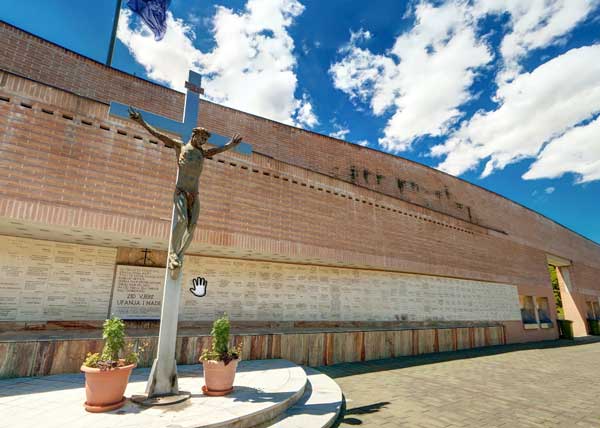

The Second Finding of the Miraculous Statue in 1684
Through the efforts of old Martin Borkovic (1667-1687), a great wor-shiper of Our Lady, a monastic Paulist, and a general of the Pauline order, and later bishop of Zagreb, the black miraculous statue of Our Lady was found again. In a discussion regarding the greatest Croatian parish festival-site of Our Lady, the eighty-seven year old bishop asked the parish priest of Bistrica, Ivan Molitoris (1679-1688): “Is it true that the Mother of God is venerated in Bistrica more than anywhere else?”
The parish priest of Bistrica was confused by the question which was in fact a claim. Bishop Martin Borkovic, remembering his young days when he went on pilgrimage to Bistrica barefoot, ordered the Zagreb canon Matija Stoklas and the Bistrica parish priest Ivan Molitoris to look once more for the miraculous statue of Our Lady.
The second finding of the statue took place on July 15, 1684. The fob lowing day, on Sunday July 16, 1684 (St. Margaret’s Sunday) the first miracle happened – a paralysed girl Katarina, Magdalena Paulec’s daughter, got back on to her feet. The newly found (and for a time forgotten) statue of Our Lady was placed on a side altar and handed over to pilgrims for worship.
Word of this miraculous finding of the statue of the Mother of God of Bistrica again, as well as the telling of the miraculous healing, got around not only to the large Zagreb diocese but also in Styria and Hungary. Streams of pilgrims or parish shrine visitors began to flow towards Bistrica. The parish priest of Bistrica, Andrija Ifsic (1688-1719), became renowned for promulgating the adoration of the Mother of God of Bistrica.


In 1706, he renounced the duty of a canon in the Zagreb cathedral chapter in order to devote himself to further spreading devotion for the miraculous Our Lady of Bistrica. Most Holy Virgin, under the name of the Mother of God of Bistrica, has been celebrated in Marija Bistrica since the miraculous statue was exposed to the public again in 1684.
The Shrine Church Became a Basilica in 1923
Due to the fact that the shrine of the Mother of God of Bistrica in Marija Bistrica was the foremost among Mary’s other shrines in Croatia, and at the request of the Zagreb archbishop Antun Bauer (1914’1937), Saint Father Pius XI (1922’1939) bestowed on the shrine and parish church in Marija Bistrica the title and rights of a minor basilica (basilica minor); it happened on December 4, 1923. Rome’s prelates bestow such a title of a minor basilica only on major cathedrals, parish churches and shrines.
The Crowning of the Miraculous Statue of the Queen of the Croats in 1935
Since the late Middle Ages, the custom has been established to crown Mary’s figures, icons, images or statues with a specially blessed crown. With the permission of the Canonical Chapter of the Roman basilica of St Peter, who were responsible for the crowning of Mary’s figures, the Zagreb archbishop Antun Bauer crowned the miraculous statue of the Mother of God of Bistrica on Sunday, July 7, 1935, on the 250th anniversary of the second finding of the statue.
It was crowned with two celebratery golden crowns; the Holy Virgin was crowned with the bigger crown and the child Jesus with a smaller one. The crowns were made in the pattern of old Croatian royal crowns and were the gift of the Croatian people. The sermon and consecration for the occasion, in front of 30.000 pilgrims, was delivered by the then archbishop coadjutor blessed Alojzije Stepinac.
Then the city of Zagreb donated to the shrine of Bistrica a golden chalice, and Croatian believers a golden rosary. On that occasion, the Zagreb archbishop and Croatian metropolitan Antun Bauer proclaimed the Most Holy Virgin Mary the Mother of God of Bistrica, the Queen of the Croats:
“Celestial Virgin, the Queen of the Croats, our Mother, our golden dawn, receive the gift of devoted hearts, receive the ardour of our pure love.”


This refrain of the well known devotional poem to Mary, composed by the martyr f. Petar Perica, D.I.,has since practically become the hymn of Mary’s Croatian worshippers.
The statue of the Mother of God of Bistrica was crowned with gilt crowns even in the 17 th century, but not in a solemn ceremony according to the church’s prescriptions. The heads of the Mother of God and the Little Jesus from the miraculous statue of Bistrica were often crowned with these old crowns. The celebratery golden crowns are placed on the black Virgin’s statue only during the Zagreb pilgrimage on the second Sunday of the month of July.
The Blessed Alojzije Stepinac and Marija Bistrica
The Zagreb archbishop and cardinal the blessed Alojzije Stepinac (1937-1960), as a devoted won shiper of the Mother of God, was connected with the shrine of the Mother of God of Bistrica. He used to walk from Zagreb at the head of the Zagreb pilgrims, to preach in Marija Bistrica, and he encouraged all the faithful to greater piety to- wards the Blessed Virgin Mary in his circular letters.
In 1939, he invited Croatian bishops, priests and believers to support the organisation of the Bistrica shrine. The same year, leading a pilgrimage to Rome on the occasion of the 1300th anniversary of the first links of the Croatian people with the Holy See, he announced the devotion of the Croatian people to the Blessed Virgin Mary, and the building of the Bistrica Calvary with the Stations of the the Cross.
On the last Sunday of October, on the feast of Jesus the King, in 1939, he laid the foundation-stone for the chapel of St Peter, at the foot of the mount below the basilica and the parish building, which would be used for giving Communion during mass pilgrimages. The chapel of St Peter is today a chapel for votive gifts, and sometimes it serves as a solemn hall for various meetings.
Archbishop Stepinac’s vow to Mary Jesus’s Mother
“We promise to remain your faithful and sincere admirers! Faithful while our small streams murmur, our rivers roar, while our dear sea foams!
Faithful until our meadows gleam green, while our meadows shine golden, while our dark woods cast a shadow, while the flowers of our country smell sweet. ”
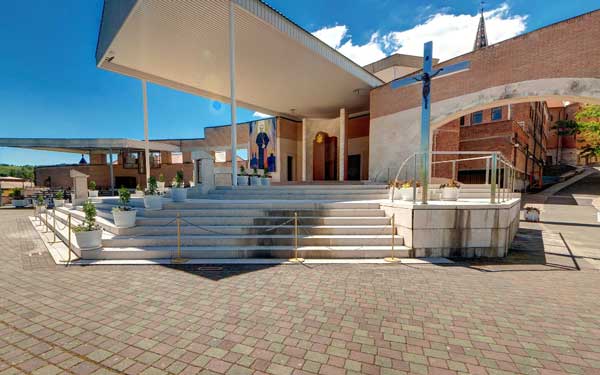

Let us remain close in the same prayer! May the Lord bless you abundantly!
Video
Let us remain close in the same prayer! May the Lord bless you abundantly!
Let us remain close in the same prayer! May the Lord bless you abundantly!
Monday – friday:
10:30 and 18:00
In carmel convent at: 7.30.
Saturday:
11:00 and 18:00
Sundays and feasts:
7:30, 9:00, 11:00 and 16:00
Let us remain close in the same prayer! May the Lord bless you abundantly!
Before every mass.
Let us remain close in the same prayer! May the Lord bless you abundantly!
Let us remain close in the same prayer! May the Lord bless you abundantly!
Let us remain close in the same prayer! May the Lord bless you abundantly!
Let us remain close in the same prayer! May the Lord bless you abundantly!
Ancient Shrine at Vinski Vrh (1499-1545)
The shrine of the Mother of God of Bistrica has a long, centuries-old history. The miraculous wooden black statue of the Holy Virgin originates from the 15 th century, and it is the work of an unknown local master devoted to believers who suffered heavy misfortune. Popular traditions says that the black wooden statue of the Mother of God (Vinnska) was first venerated in a wooden chapel, the earliest shrine of Bistrica, at Vinski Vrh from 1499 to 1545. Vinski Vrh is situated above the valley of the river Krapina and Zlatarsko Polje at an altitude of 282m, between Marija Bistrica and Konjščina, about three kilometres away from today’s shrine in Marija Bistrica. Due to the permanent Turkish danger, especially after the Turks defeated the army of Nikola Zrinski at Konjščina on May 4, 1545, the parish priest Pavao (plebenus Paulus de Bisthriza) transferred the miraculous statue of Our Lady to Bistrica and buried it secretly under the choir of the parish church. He took the secret about the statue with him to his tomb.
The First Finding of the Miraculous Statue in 1588
Our Lady’s followers were con- stantly searching for the miraculous statue. The uncertainty was re- solved by a strange light coming from the choir of the parish church in Bistrica after the evening service. The folowing day the undamaged statue of Our Lady was unearthed. It was in 1588 during the parish priest Luka’s tenure, and, according to some documents, the parish priest Antun Plavasic’s (1574T590). This was the first finding of the statue of the Mother of God of Bistrica and its setting up on the altar for worship.
The Hiding Again of the Miraculous Statue in 1650
Due to constant Turkish danger, when the Turks invaded the country as far as Zlatarsko Polje in 1650, the statue was hidden for the second time. It was placed in the area be- hind the main altar in the parish church and walled in, but an opening was left for Our Lady’s face. Pilgrimages to Bistrica became less be-cause of the constant Turkish invasions, peasants’ revolts, and the fact that the statue was hidden.
On the second Sunday of September, Our Lady twice appeared to the parish priest Petar Brezaric (1676-1679). In the parish church in the morning, while he was preaching about St Francis Xavier (Franjo Ksaverski). All at once a woman of noble appearance, dressed in blue clothes, approached the pulpit, with a burning candle in her hand, pleading with the priest to pray, together with the congregation, for her sight. The same day in the afternoon, the same “lady” appeared to him in the hamlet of Podgrade, near the house of the Balogovic family, while he was riding in a carriage, together with the chaplain, on his way to the manor of Malenici. When he tried to approach her, “the lady” disappeared. There was a lot of talk about that apparition even after Brezaric’s death, but without having much importance attached to it. Nevertheless, it was surely the Virgin Mary’s plea to be able to see again behind the altar wall, where the black statue of Our Lady of Bistrica was walled in.
The Second Finding of the Miraculous Statue in 1684
Through the efforts of old Martin Borkovic (1667-1687), a great wor-shiper of Our Lady, a monastic Paulist, and a general of the Pauline order, and later bishop of Zagreb, the black miraculous statue of Our Lady was found again. In a discussion regarding the greatest Croatian parish festival-site of Our Lady, the eighty-seven year old bishop asked the parish priest of Bistrica, Ivan Molitoris (1679-1688): “Is it true that the Mother of God is venerated in Bistrica more than anywhere else?” The parish priest of Bistrica was confused by the question which was in fact a claim. Bishop Martin Borkovic, remembering his young days when he went on pilgrimage to Bistrica barefoot, ordered the Zagreb canon Matija Stoklas and the Bistrica parish priest Ivan Molitoris to look once more for the miraculous statue of Our Lady.
The second finding of the statue took place on July 15, 1684. The fob lowing day, on Sunday July 16, 1684 (St. Margaret’s Sunday) the first miracle happened – a paralysed girl Katarina, Magdalena Paulec’s daughter, got back on to her feet. The newly found (and for a time forgotten) statue of Our Lady was placed on a side altar and handed over to pilgrims for worship. Word of this miraculous finding of the statue of the Mother of God of Bistrica again, as well as the telling of the miraculous healing, got around not only to the large Zagreb diocese but also in Styria and Hungary. Streams of pilgrims or parish shrine visitors began to flow towards Bistrica. The parish priest of Bistrica, Andrija Ifsic (1688-1719), became renowned for promulgating the adoration of the Mother of God of Bistrica. In 1706, he renounced the duty of a canon in the Zagreb cathedral chapter in order to devote himself to further spreading devotion for th. miraculous Our Lady of Bistrica. 1 e Most Holy Virgin, under the name ot the Mother of God of Bistrica, has been celebrated in Marija Bistrica <ince the miraculous statue was exposed to the public again in 1684.









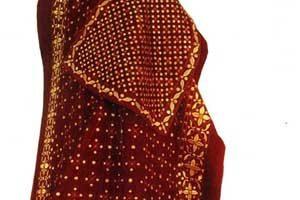





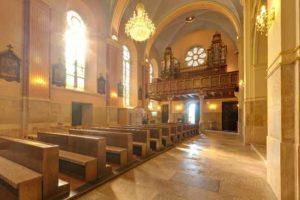
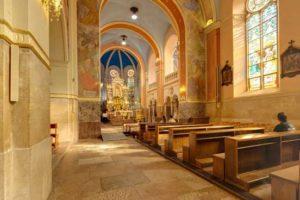
















We went there, during the week day, so nobody was there. We were alone in the church, able to pray. Inside you can take the holy water already in bottles. Very beautiful. Nearby is the Carmel convent and a nice book store where you can by candles with different motives.
Very nice, but smaller Marian shrine. I suggest that you visit it during the weekend.